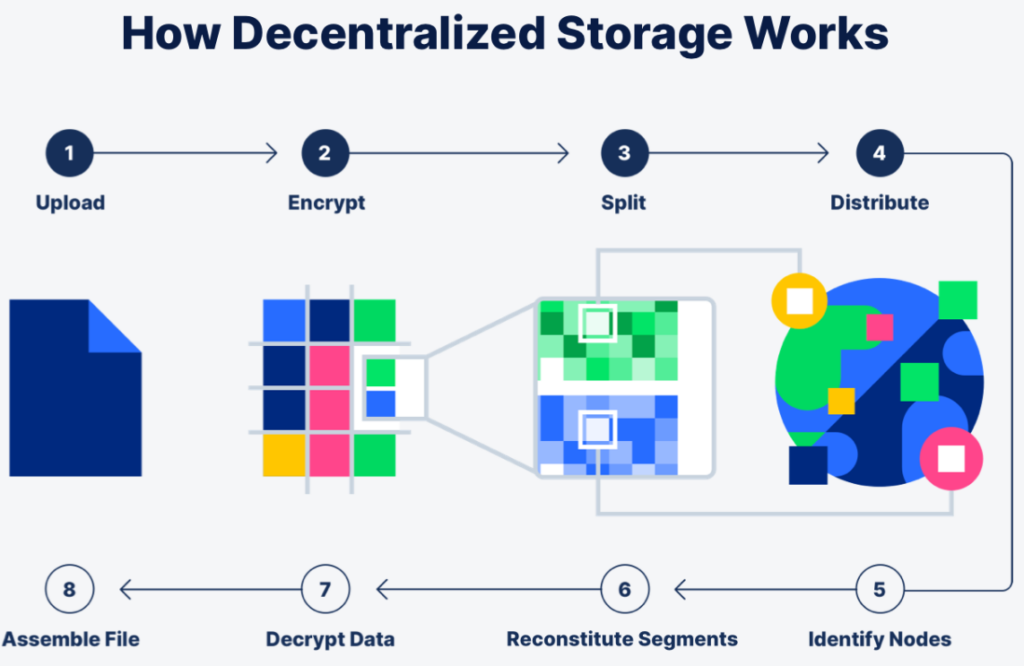Recently, Elon Musk has put a temporary limit on the number of tweets that we can see each day. However, this move may also have financial reasons. Furthermore, Twitter was making headlines for not paying its Google Cloud bills.
So, decentralized space storage may be an alternative. Let’s take a look at 4 decentralized space storage projects.
What Is Decentralized Space Storage?
In decentralized space storage, you can distribute data across different servers. On the other hand, cloud storage stores all files on one centralized system. For example, like Twitter. Samples of decentralized storage systems are, for instance,
Here are some major benefits of decentralized space storage. For example,
- No single point of failure – There’s no central database. Each single file gets encrypted. It’s also spread over hundreds of servers. In other words, if one server fails, you can still access your data through a different sever.
- Security and privacy increases – Security depends on each single server. This reduces data loss risk and hackers have a hard time gaining access to data.
- Reliability and redundancy increase – The system stores files on a variety of servers. This minimizes failures and increases redundancy. So, you will not lose files due to crashes or various technical errors.
- Speed enhances – For instance, in StorX, it’s the system that queries the network. Now it fetches data from the closest nodes. This results in optimal data retrieval speeds.
- Scalable and resource efficient – It leverages all resources of the nodes that take part.
- Lower cost – In general, cloud storage is pricier. It needs extra servers and staff to run and maintain it. On the other hand, you can become part of the network and earn passive income with spare storage capacity.
Here’s a picture of how decentralized space storage can work.
Source: Storj
Centralized vs Decentralized Storage (Cost Analysis)
In general, decentralized storage is cheaper than centralized storage. That’s by a wide margin. Enterprise-grade centralized storage can cost up to 100X more than enterprise-grade decentralized storage. Our research team made a comparison table of this.
| Google Cloud | Amazon S3 | Arweave | FileCoin | Storj |
Sia |
| $23/TB monthly | $5.1K/TB one-time lifetime | $0.19/TB monthly | $4/TB monthly |
As this table shows, the price differences are immense. So, it’s time to look at some Web3 alternatives.
1) Arweave (AR)
Arweave offers data storage on a decentralized network of devices. It claims to offer permanent storage for a single up-front fee. However, technically, it guarantees 200 years of storage. For example, it’s known for saving culturally and historically important data. It does this in an immutable Library of Alexandria.
Instagram/Meta also used it, as part of their NFT displays. However, that didn’t last very long, they already abandoned this. Here’s a handy fee calculator that shows you how storage will cost you on Arweave. It works on two layers.
- Blockweave – Arweave stores its data in a graph of blocks. Each block links to two earlier blocks in Arweave. This forms a structure called a ‘blockweave.’
- Permaweb – Everything published on the permaweb is available forever. The permaweb offers low-cost, zero maintenance, permanent hosting of web apps and web pages.
The following video gives a short explanation of Arweave.
2) Filecoin (FIL)
Filecoin is an open-source cloud storage network. It supports the InterPlanetary File System (IPFS). It works with two features:
- PoRep – This is cryptographic proof that a miner has replicated a client’s data in its entirety.
- PoSt – Proves that the data has been continuously stored for a specified duration.
So, you choose a miner who stores your personal data, and you pay him with FIL tokens. Filecoin operates independently of IPFS. However, it shares some of its ideas. To clarify this, they built IPFS for short-term retrieval of data. On the other hand, Filecoin is for longer-term continuance of data. The following video gives a short explanation of Filecoin:
3) Storj (STORJ)
Storj is another decentralized cloud storage network. It’s S3 compatible (Simple Storage Service) and it’s peer-to-peer encrypted. The protocol uses a variety of important stages in the storage of data. For instance:
- Encryption of the data.
- Sharding of the data.
- Distribution of data throughout the network.
For this, it uses three main components.
- Storage Nodes – These allow you to rent out excess space on your hard drives. You can store and return data for a fee in a reliable way.
- Uplinks – These run on the client’s machine. They upload files to the network. Furthermore, they also coordinate with peers to store and retrieve data.
- Satellites – They coordinate traffic between uplinks and the storage nodes. Storj uses satellites for storing metadata. This keeps the storage nodes honest. Every user has a separate account on a satellite.
Discover how you can unleash the power of AI creativity with VALDI and seamlessly integrate Cloud Storage and Computing! https://t.co/dEu2cVsqFq
#MachineLearning #GenerativeAI #DistributedCloudComputing— Storj (@storj) July 18, 2023
4) Siacoin (SC)
Sia is like a marketplace. There are buyers who want to store files. On the other side, you have storage space suppliers. The suppliers receive the SC token as payment. Prices are dynamic. The suppliers determine the price. However, keep in mind that the SC token has no max supply.
Sia divides stored files into 30 encrypted segments. It uploads each segment to a unique host. This creates great redundancy.
🚀 #hostd beta is live! Experience enhanced stability, speed, resource management, and a user-friendly interface. Welcome to the future of #decentralized storage.👇 1/5 pic.twitter.com/ATI2FOVHei
— Sia Foundation (@Sia__Foundation) July 5, 2023
Conclusion
We looked at four decentralized space storage Dapps. These included Arweave, Filecoin, Storj, and Sia. You can also find an explanation of what decentralized space storage is. We also complemented this with some benefits.
⬆️ For more cryptocurrency news, check out the Altcoin Buzz YouTube channel.
⬆️ Our popular Altcoin Buzz Access group generates tons of alpha for our subscribers. And for a limited time, it’s Free. Click the link and join the conversation today.





























